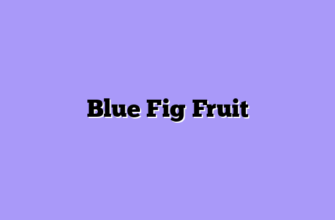Here in the rolling hills just outside of San Diego, the morning fog usually burns off by roughly 10 a.m., revealing a sun that feels like it was specifically calibrated for growing sugar. I’m out in the orchard before the heat really sets in, checking the irrigation lines and inspecting the canopy. While I grow a lot of strange stuff—from Dragon Fruit to Cherimoya—there is something ancient and deeply satisfying about the Ficus carica, or as you likely know it, the common fig.

You might think, “Why on earth would we discuss the seeds? Aren’t they just the annoyance stuck between my teeth?” Well, hold your horses. That tiny seed is the architect of the fruit’s texture and the subject of one of the most fascinating biological lotteries on the planet.
The Inverted Flower and the Wasp Connection
Let’s get the science out of the way, but I promise to keep it painless. The fig isn’t actually a fruit in the botanical sense; it’s a syconium. Think of it as a flower that blossomed inward rather than outward. When you bite into a fig, you are essentially eating hundreds of tiny flowers.
Those little crunchy bits? In a technical sense, those are the fruits. Each “seed” is a hard-shelled vessel containing the actual genetic material. In the farming world, and especially among my Hispanic neighbors here in Southern California, we often call the fruit Higo, and the tree Higuera. If you travel to parts of Asia, you’ll hear it called Anjeer. But whatever you call it, the biology remains the same.
Here is the kicker: nature designed these “seeds” to be pollinated by a specific microscopic partner—the fig wasp (Blastophaga psenes). Now, before you panic and throw out your Fig Newtons, you need to know that the vast majority of figs grown here in the US (like the Mission or Kadota varieties) are “Common Figs.” They are parthenocarpic. That’s a fancy ten-dollar word meaning they produce fruit without pollination. The seeds inside are hollow shells. They give you the crunch, but they won’t grow a tree.
However, if you eat a Calimyrna fig (the big, nutty, yellow ones often sold dried), those seeds are fertile. They were pollinated. That nuttiness you taste? That’s the flavor of a true, viable seed.
The Genetic Lottery: Why I Don’t Plant Seeds
I often have visitors to the farm ask me, “If I plant the seeds from this delicious fig I just ate, will I get a tree just like this one?”
The short answer is: absolutely not.
Growing figs from seed is like rolling dice in a casino where the house has a massive advantage. I once tried this experiment early in my farming career. I took fertile seeds from a hybrid variety, stratified them, and planted about fifty of them.
Here is the reality of fig genetics:
-
The Gender Gap: Roughly 50% of the seedlings will turn out to be male trees, known as Caprifigs. These produce small, dry, inedible fruits that are full of pollen but useless for your breakfast table.
-
The Wild Card: Even if you get a female tree, it won’t be identical to the parent. It’s a new genetic mix. You might get a fruit that tastes like cardboard, or one that drops off the tree before it ripens.
This is why professional growers, myself included, rely on cuttings. We clone our trees. If I have a “Black Madeira” that tastes like raspberry jam and molasses, I want my new tree to do exactly the same thing. So, I snip a branch, root it, and voila—genetic certainty.
Here is a quick breakdown of why we choose one method over the other:
Table 1: The Grower’s Dilemma – Seed vs. Cutting
| Feature | Growing from Seed | Growing from Cutting (Cloning) |
| Genetic Outcome | Completely random (The “Lottery”) | Identical to the parent tree |
| Time to Fruit | 3 to 7 years (and might be male) | 1 to 2 years |
| Fruit Quality | Unknown; likely inferior | Known and predictable |
| Root System | often develops a strong taproot | Fibrous, spreading root system |
| Purpose | Breeding new varieties | Production and reliability |
The Culinary Crunch: Why We Need the Seed
So, if the seeds are mostly hollow in my Black Mission figs, are they useless? Not by a long shot.
Imagine eating a fig that was smooth like pudding all the way through. It would be boring, right? It would lack character. The seed provides textural contrast. In the culinary world, texture is flavor’s dancing partner. When you chew a fig, the breaking of those tiny sclerified pits releases small amounts of nut oils (in fertile figs) or simply provides a rhythmic crunch that offsets the gooey sweetness of the flesh.
From a nutritional standpoint, even the hollow seeds are packed with fiber. In my kitchen, we don’t just eat the fruit raw. We process them in ways that highlight that seed density.
Here are a few ways we utilize the “seediest” varieties on the farm:
-
Fig Jams and Pastes: We cook the fruit down until it’s thick. The seeds suspend in the jelly, looking like stars in a galaxy. The crunch breaks up the monotony of the sugar.
-
Roasted Higo: Halve them, top with goat cheese and a walnut, and roast them. The heat makes the seeds slightly more brittle and nutty.
-
Dehydrated Chips: When you dry a fig, the skin gets chewy, but the seeds get harder. It turns into a wholesome candy.
I remember one season we had a bumper crop of “Brown Turkey” figs—a variety often maligned for having a somewhat watered-down flavor compared to the intense berry notes of an “Adriatic.” However, the seed count was incredibly high. We dried them out, chopped them up, and used them in a granola mix. The customers couldn’t stop raving about it. They didn’t care about the complex berry notes; they loved the texture.
So, You Still Want to Plant One?
Okay, I can see you’re stubborn. I like that. That’s the spirit of a farmer. If you are determined to grow a Ficus carica from seed, perhaps to hunt for a new variety or just for the sheer joy of watching life erupt from soil, you need to do it right.
San Diego is perfect for this because we rarely get a hard freeze, but you can do this indoors anywhere. Just remember, you need viable seeds. Store-bought fresh figs are usually sterile. You need to buy dried Calimyrna figs or order specific seeds from a breeder.
Here is the protocol I use when I’m feeling lucky and want to breed a new variety:
-
Extraction: Scoop the seeds out of a ripe, fertile fruit. Place them in a glass of water. The good seeds will sink; the hollow duds will float. Skim off the floaters and toss them in the compost.
-
The Clean-Up: Wash the sinking seeds in a fine-mesh sieve to remove all the sugary pulp. This is crucial—pulp invites mold, and mold is the enemy of germination.
-
The Bedding: Prepare a mix of perlite and peat moss. You want it moist, like a wrung-out sponge, not soaking wet.
-
The Incubator: Sprinkle the seeds on top of the soil (they need light to germinate) and cover the container with plastic wrap to create a mini-greenhouse. Keep it warm—around 75°F (24°C).
-
The Wait: It can take anywhere from 2 weeks to 3 months. Be patient.
Varieties That Thrive Here
San Diego has a unique climate—we have the coastal influence and the inland valleys. This allows us to grow varieties that might rot in the humidity of Florida or freeze in the winters of New York.
When we talk about seeds, we are usually talking about the end result of the fruit. But the variety determines the “seed-feel” (mouthfeel) of the fruit.
Table 2: Common San Diego Varieties and Their “Seediness”
| Variety Name | Skin Color | Flavor Profile | Seed Texture |
| Black Mission | Deep Purple/Black | Earthy, sweet, melon-like | Fine, soft seeds, moderate crunch |
| Kadota | Green/Yellow | Honey, light, simple | Very few seeds, smooth texture |
| Calimyrna | Golden/Brown | Nutty, butterscotch | Large, hard, fertile seeds (Maximum Crunch) |
| Panache (Tiger) | Striped Green/Yellow | Berry jam, bright acidity | Moderate seeds, very chewy skin |
The Farmer’s Philosophy
Every time I walk through my rows of trees, I see the history of agriculture. The fig is one of the oldest cultivated plants known to humanity. It predates wheat. By cloning our trees through cuttings, we are essentially keeping an organism alive that might have started growing hundreds or thousands of years ago.
But the seed represents the future. It represents mutation, change, and adaptation. While I might not rely on seeds to pay the mortgage—I need those consistent yields from my cloned cuttings for that—I respect the seed.
There is a specific case study from a few years back that sticks with me. A friend of mine in the Vista area found a random seedling growing out of a crack in his driveway. He almost pulled it. Instead, he transplanted it. Three years later, it produced a fig with purple skin and a bright neon-red interior that tasted like strawberry candy. He named it the “Vista Berry.” That accident, that roll of the dice, created something wonderful.
So, next time you bite into a fresh fig, close your eyes. Feel that grit between your teeth. Don’t be annoyed by it. Appreciate it. That is the sound of nature’s resilience, a tiny package of DNA that has traveled through history to get to your plate.
And if you’re ever in San Diego, stop by the farm. I’ll cut you a fresh one, straight off the branch, and we can see if we can taste the difference between a hollow seed and a fertile one. Just watch out for the wasps—I’m kidding, mostly.








